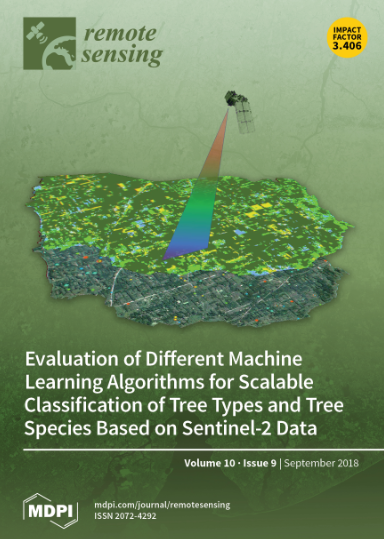利用空间光谱特征对沿海盐沼中的无人机激光雷达进行基于 ANN 的过滤
IF 4.1
2区 地球科学
Q2 ENVIRONMENTAL SCIENCES
引用次数: 0
摘要
盐沼为多种生物提供了多样化的栖息地,在抵御极端海洋灾害方面为沿海社区发挥着重要的防御和缓冲作用。准确获取盐沼地形对于沿海资源和生态的综合管理和保护至关重要。然而,茂密的植被覆盖、周期性的潮水淹没和无处不在的沟渠分布,给盐沼地形的测量或估算带来了挑战。这些环境因素使得大多数现有技术和方法在数据采集分辨率、准确性和效率方面效果不佳。无人机多线光探测与测距(LiDAR)为三维点云数据采集提供了一个全新的视角,在准确推导盐沼地形方面可能表现出巨大的优势。利用无人机多线激光雷达数据进行地形特征描述的前提是点云过滤,这意味着必须将地面点与非地面点区分开来。现有的过滤方法通常依赖于激光雷达的几何特征或强度特征。这些方法在植被茂密、多样且复杂的盐沼中可能效果不佳。本研究基于人工神经网络(ANN)机器学习模型,提出了一种新的盐沼无人机多线激光雷达点云过滤方法。首先,从原始数据中导出一系列单个(如高程、距离和强度)和邻域(如特征值、线性度和球度)尺度的空间光谱特征。然后,对得出的空间光谱特征进行筛选,去除相关和冗余特征,以优化 ANN 模型的性能。最后,将保留的特征作为输入变量整合到 ANN 模型中,以描述它们与不同视角下的点类别(地面或非地面)之间的非线性关系。利用无人机 6 线激光雷达对长江口两片典型盐碱地进行了案例研究,证明了所提滤波方法的有效性和普适性。所获得的平均 G 均值和 AUC 分别为 0.9441 和 0.9450,优于传统的基于几何信息的方法和其他先进的机器学习方法,以及深度学习模型(RandLA-Net)。此外,与使用单一类型或单一尺度的特征相比,整合单个邻域尺度的空间光谱特征能带来更好的过滤效果。所提出的方法为无人机激光雷达点云滤波和盐沼地形推导提供了一种创新策略,是几何数据和辐射数据深度整合的新颖解决方案。本文章由计算机程序翻译,如有差异,请以英文原文为准。
ANN-Based Filtering of Drone LiDAR in Coastal Salt Marshes Using Spatial–Spectral Features
Salt marshes provide diverse habitats for a wide range of creatures and play a key defensive and buffering role in resisting extreme marine hazards for coastal communities. Accurately obtaining the terrains of salt marshes is crucial for the comprehensive management and conservation of coastal resources and ecology. However, dense vegetation coverage, periodic tide inundation, and pervasive ditch distribution create challenges for measuring or estimating salt marsh terrains. These environmental factors make most existing techniques and methods ineffective in terms of data acquisition resolution, accuracy, and efficiency. Drone multi-line light detection and ranging (LiDAR) has offered a fire-new perspective in the 3D point cloud data acquisition and potentially exhibited great superiority in accurately deriving salt marsh terrains. The prerequisite for terrain characterization from drone multi-line LiDAR data is point cloud filtering, which means that ground points must be discriminated from the non-ground points. Existing filtering methods typically rely on either LiDAR geometric or intensity features. These methods may not perform well in salt marshes with dense, diverse, and complex vegetation. This study proposes a new filtering method for drone multi-line LiDAR point clouds in salt marshes based on the artificial neural network (ANN) machine learning model. First, a series of spatial–spectral features at the individual (e.g., elevation, distance, and intensity) and neighborhood (e.g., eigenvalues, linearity, and sphericity) scales are derived from the original data. Then, the derived spatial–spectral features are selected to remove the related and redundant ones for optimizing the performance of the ANN model. Finally, the reserved features are integrated as input variables in the ANN model to characterize their nonlinear relationships with the point categories (ground or non-ground) at different perspectives. A case study of two typical salt marshes at the mouth of the Yangtze River, using a drone 6-line LiDAR, demonstrates the effectiveness and generalization of the proposed filtering method. The average G-mean and AUC achieved were 0.9441 and 0.9450, respectively, outperforming traditional geometric information-based methods and other advanced machine learning methods, as well as the deep learning model (RandLA-Net). Additionally, the integration of spatial–spectral features at individual–neighborhood scales results in better filtering outcomes than using either single-type or single-scale features. The proposed method offers an innovative strategy for drone LiDAR point cloud filtering and salt marsh terrain derivation under the novel solution of deeply integrating geometric and radiometric data.
求助全文
通过发布文献求助,成功后即可免费获取论文全文。
去求助
来源期刊

Remote Sensing
REMOTE SENSING-
CiteScore
8.30
自引率
24.00%
发文量
5435
审稿时长
20.66 days
期刊介绍:
Remote Sensing (ISSN 2072-4292) publishes regular research papers, reviews, letters and communications covering all aspects of the remote sensing process, from instrument design and signal processing to the retrieval of geophysical parameters and their application in geosciences. Our aim is to encourage scientists to publish experimental, theoretical and computational results in as much detail as possible so that results can be easily reproduced. There is no restriction on the length of the papers. The full experimental details must be provided so that the results can be reproduced.
 求助内容:
求助内容: 应助结果提醒方式:
应助结果提醒方式:


